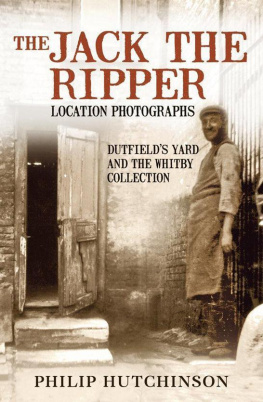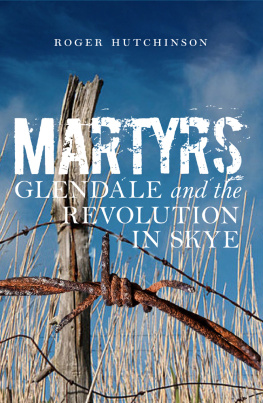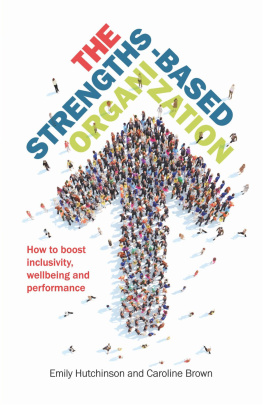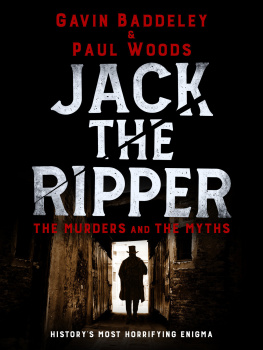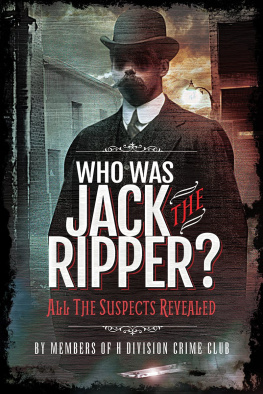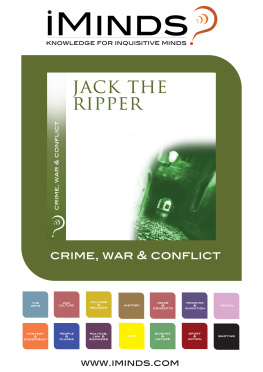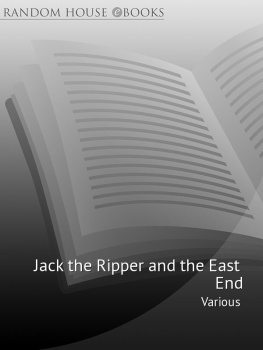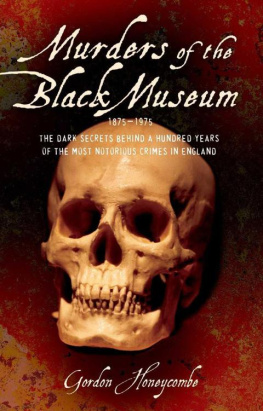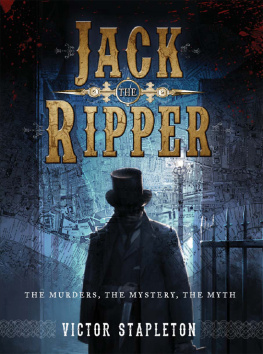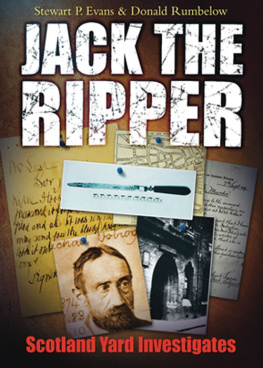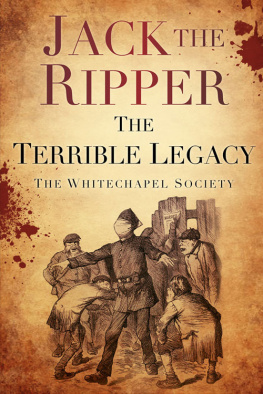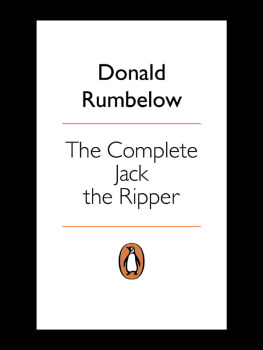THE
Jack the Ripper
LOCATION
PHOTOGRAPHS
THE
Jack the Ripper
LOCATION
PHOTOGRAPHS
D UTFIELDS Y ARD AND THE
W HITBY C OLLECTION
PHILIP HUTCHINSON
AMBERLEY
First published 2009
Reprinted 2012
Amberley Publishing
The Hill, Stroud
Gloucestershire, gl5 4EP
www.amberley-books.com
Philip Hutchinson, 2009, 2012
The right of Philip Hutchinson to be identified as the Author of this work has been asserted in accordance with the Copyrights, Designs and Patents Act 1988.
All rights reserved. No part of this book may be reprinted or reproduced or utilised in any form or by any electronic, mechanical or other means, now known or hereafter invented, including photocopying and recording, or in any information storage or retrieval system, without the permission in writing from the Publishers.
British Library Cataloguing in Publication Data.
A catalogue record for this book is available from the British Library.
ISBN 978-1-84868-784-4 (PRINT)
ISBN 978-1-4456-1045-0 (e-BOOK)
Typesetting and Origination by Amberley Publishing.
Printed in Great Britain.
Contents
About the Author
Philip Hutchinson is the author of several history books, amongst them The London of Jack The Ripper Then and Now (Breedon Books, 2007), co-authored with Robert Clack. An actor by profession, he is now one of the worlds best-known and respected Jack the Ripper tour guides in London. He has lectured on aspects of the case in the UK and USA and has featured many times on TV, radio and podcasts discussing the Ripper. In 2007, he twice had the fortune to acquire extremely important and previously unknown photographs of the murder locations, which form part of his extensive collection of true crime ephemera. Philip has been a Council Member of the worlds oldest paranormal organisation, The Ghost Club, since 2001 and has for some years also played the role of emcee for The Whitechapel Society 1888. He lives in Guildford, Surrey.
Introduction
This is not a book about Jack the Ripper. The available canon of Ripperological literature runs into three figures. This modest work concerns two sets of photographs, unrelated except for their subject matter, and taken sixty years apart. Some of these images were first published in the book I wrote with Robert Clack, The London of Jack the Ripper Then and Now , (Breedon Books, 2007) but others have previously only been seen publicly at lectures and are published here for the first time.
This is also not a book that will become a best-seller. Its demographic is marginal and the issues covered will only appeal to a limited number of those individuals.
Having moved on from generic knowledge of the case, many students of Ripper history now concentrate on other areas. A good proportion are interested in contemporary images of the East End of London and especially those locations with connections to the sequence of brutal murders that occurred in 1888. Although historical information is still being uncovered (albeit that it is widely acknowledged a Eureka! moment is highly unlikely), some of the most exciting discoveries in research in the last few years have been photographic. I am fortunate indeed that I find myself the owner of many of these images.
I am the first to admit that the term expert is relative and few in the field would class themselves as such. It has been a constant source of bewilderment to me that I have any standing amongst serious Ripper historians as I truly feel dwarfed in my understanding of the case compared to many of my associates, a good deal of whom have never published anything, but whose skills give flesh and bones to the writings of we others. The list of acknowledgements overleaf will bear testament to the fact that research is best undertaken in a pack.
In the first half of this book, you will find reproductions of every image from The Whitby Collection along with modern-day comparison shots. The known story of the life of the photographer is discussed. Following this, there is a detailed account of the painstaking research that went into the verification of an image some have cited as the most important photographic discovery in the case for twenty years, taken by one of the first Ripper Tourists when Queen Victoria still sat on the throne.
This book is dedicated to Margaret and Norman, and to Larry the people from whom I obtained these photographs. Without them, you would not be able to see what you are about to see. I further wish to publicly offer my thanks to Brenda and Ed in Maryville, Tennessee, for their support and presence when I lectured on the case in the US in 2008.
Philip Hutchinson
Guildford
August 2009
Acknowledgements
I wish to give my thanks to the assistance and research skills of a large number of Ripper historians, and to individuals from organisations, who assisted (or offered to assist) me in my endeavours. They are, alphabetically:
Debra Arif, Paul Begg, Neil Bell, Tony Brewer, Robert Clack, Mike Covell, Ellen Engseth (UWM Libraries, Milwaukee), Stewart P Evans, Martin Fido, Chris George, Paul Gjenvick (Gjenvick-Gjnvick Archives), Margaret and Norman Green, Dee Anna Grimsrud (Wisconsin Historical Society), Jeff Korman (University of Baltimore), Larry Lingle, Jake Luukanen, Pete McClelland, Al Muchka (Milwaukee Public Museum), John Nondorf (Wisconsin Historical Society), Dr Timothy Riordan, Thomas Schachner, Chris Scott, Neal Sheldon, Jonathan Shorr PhD (University of Baltimore), Paul Smith (Thomas Cook Archives), Geraldine Strey (Wisconsin Historical Society), Dennis Weidner, Tom Wescott, Gareth Williams.
John Gordon Whitby
In the summer of 2000, I took a holiday in Lincoln. It was a type of package holiday organised by an elderly couple who ran a company providing educational historical excursions to parts of England. The holiday was not the most interesting of events and seemed to be comprised almost solely of long-retired couples lacking in any social skills. Given the option of attending a slide show about the town of Stamford or venturing out by myself, I chose the latter and left the building to attend Lincolns Ghost Walk.
Margaret Green has run these popular walks in the city for some years and once escorted Tom Hanks on a private tour whilst he was filming The Da Vinci Code in Lincoln Cathedral. Not only did I find her guiding infinitely more engaging than the uninspired mutterings of the holiday organisers but we struck up an instant rapport and I stayed in touch once her tour was over.
I have been a Council Member of the worlds oldest paranormal organisation, The Ghost Club, since 2001 and, as Events Officer, it is my responsibility to book speakers on the subject of ghosts and hauntings for the groups monthly lectures in central London. Thus it was that, having met with Margaret and her husband Norm in Lincoln a couple of times since 2000, I booked her to speak in April 2007.
Before the talk began, we sat in the venues bar to catch up on the years respective gossip. In passing conversation Margaret commented that she had found something in her kitchen drawer at home that may interest me. Knowing that I was already by that time a Jack the Ripper tour guide of some years standing in the East End, she said that her uncle had taken some photos of locations connected to the crimes in the 1960s and wondered if I would like to see them. The gap between the end of her question and my reply was almost impossibly short.
Within days, a padded envelope fell through my letterbox, sent Recorded Delivery. As I walked down a Guildford hill on my way to work, I ripped the packaging open to find a cheap blue 24-page photo album inside. A label stuck on the front, in Margarets handwriting, bore the words Views of where Jack the Ripper killed his victims taken by JOHN G WHITBY . As I flicked the album open, I found a modern press cutting about the murders cut from a broadsheet and a set of ten cream-coloured envelopes. All the Basildon Bond envelopes were yellowing with age and all had clearly been written upon in black ink at the same time. The first envelope in the series read looking towards Dorset ST from Thrawl st .
Next page
